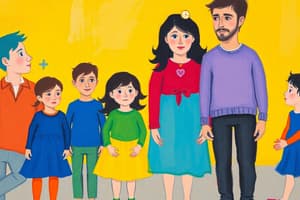Podcast
Questions and Answers
How have evolving legal frameworks in Canada primarily contributed to changes in family structures?
How have evolving legal frameworks in Canada primarily contributed to changes in family structures?
- By legally recognizing same-sex marriage and common-law partnerships, thus diversifying family forms. (correct)
- By enforcing stricter definitions of the nuclear family.
- By increasing restrictions on common-law partnerships.
- By reducing the rights and responsibilities of divorced parents.
Which factor most significantly influences a child's well-being, irrespective of family structure, according to research?
Which factor most significantly influences a child's well-being, irrespective of family structure, according to research?
- The number of siblings the child has.
- The child's involvement in extracurricular activities.
- The quality of relationships and nurturing within the family. (correct)
- The level of financial resources available to the family.
What is a primary challenge faced by blended families in comparison to nuclear families?
What is a primary challenge faced by blended families in comparison to nuclear families?
- Reduced access to healthcare services.
- Less community support.
- Lower levels of parental education.
- Difficulty integrating different family systems and traditions. (correct)
Which of the following best describes the impact of increased female participation in the workforce on Canadian family structures?
Which of the following best describes the impact of increased female participation in the workforce on Canadian family structures?
Why might immigrant families in Canada maintain more traditional family structures and values compared to non-immigrant families?
Why might immigrant families in Canada maintain more traditional family structures and values compared to non-immigrant families?
What is a significant economic factor contributing to the rise of multigenerational households in Canada?
What is a significant economic factor contributing to the rise of multigenerational households in Canada?
How does the legal recognition of common-law partnerships in Canada affect the rights and responsibilities of couples?
How does the legal recognition of common-law partnerships in Canada affect the rights and responsibilities of couples?
Which of the following is a unique challenge faced by Indigenous families in Canada?
Which of the following is a unique challenge faced by Indigenous families in Canada?
What is the primary goal of government policies and programs aimed at supporting Canadian families?
What is the primary goal of government policies and programs aimed at supporting Canadian families?
Which of the following is NOT a typical challenge faced by Canadian families today?
Which of the following is NOT a typical challenge faced by Canadian families today?
How has technology impacted family dynamics in Canada?
How has technology impacted family dynamics in Canada?
Why is understanding the diversity of Canadian family structures important for policymakers?
Why is understanding the diversity of Canadian family structures important for policymakers?
Which of the following factors is least likely to influence family structure in Canada?
Which of the following factors is least likely to influence family structure in Canada?
What is a potential impact of divorce and separation on family members?
What is a potential impact of divorce and separation on family members?
How do adoption and foster care contribute to the diversity of family structures in Canada?
How do adoption and foster care contribute to the diversity of family structures in Canada?
In what way do Assisted Reproductive Technologies (ART) impact the concept of family formation?
In what way do Assisted Reproductive Technologies (ART) impact the concept of family formation?
What is a key characteristic of Indigenous family structures in Canada?
What is a key characteristic of Indigenous family structures in Canada?
Which factor poses a significant challenge for immigrant and refugee families when they are integrating into Canadian society?
Which factor poses a significant challenge for immigrant and refugee families when they are integrating into Canadian society?
What is the significance of efforts to revitalize Indigenous languages and cultural practices within families?
What is the significance of efforts to revitalize Indigenous languages and cultural practices within families?
What is a long-term expected trend that will likely shape Canadian family structures?
What is a long-term expected trend that will likely shape Canadian family structures?
Flashcards
Nuclear Family
Nuclear Family
A family consisting of two parents and their children.
Single-Parent Family
Single-Parent Family
A family with one parent raising one or more children.
Blended Family
Blended Family
A family formed when parents remarry, bringing children from previous relationships together.
Common-Law Family
Common-Law Family
Signup and view all the flashcards
Extended Family
Extended Family
Signup and view all the flashcards
Same-Sex Families
Same-Sex Families
Signup and view all the flashcards
Childless Couples
Childless Couples
Signup and view all the flashcards
Cultural Background (Influence)
Cultural Background (Influence)
Signup and view all the flashcards
Socioeconomic Status (Influence)
Socioeconomic Status (Influence)
Signup and view all the flashcards
Education (Influence)
Education (Influence)
Signup and view all the flashcards
Geographic Location (Influence)
Geographic Location (Influence)
Signup and view all the flashcards
Legal & Policy Changes (Influence)
Legal & Policy Changes (Influence)
Signup and view all the flashcards
Multigenerational Households
Multigenerational Households
Signup and view all the flashcards
Indigenous Families
Indigenous Families
Signup and view all the flashcards
Immigrant and Refugee Families
Immigrant and Refugee Families
Signup and view all the flashcards
Adoption
Adoption
Signup and view all the flashcards
Foster Care
Foster Care
Signup and view all the flashcards
Assisted Reproductive Technologies (ART)
Assisted Reproductive Technologies (ART)
Signup and view all the flashcards
Study Notes
- The Canadian family has undergone significant transformation over the past few decades, moving away from the traditional nuclear family model.
- Diversity in family structures is now a prominent characteristic of Canadian society.
Historical Context
- Historically, the nuclear family (two parents and their children) was considered the norm in Canada.
- This model was often associated with specific gender roles and economic structures.
- Changing social attitudes, increased female participation in the workforce, and evolving legal frameworks have all contributed to the diversification of family forms.
Common Family Structures in Canada
- Nuclear Families: Although less prevalent than in the past, nuclear families still exist in Canada.
- Single-Parent Families: These families consist of one parent raising one or more children. Single-parent families are often headed by women, but the number of single-father families is increasing.
- Blended Families: Formed when parents remarry or re-partner, bringing children from previous relationships together.
- Common-Law Families: Couples who live together in a conjugal relationship without being legally married. Common-law partnerships are legally recognized in Canada.
- Extended Families: Include relatives beyond parents and children living in the same household.
- Same-Sex Families: Same-sex couples raising children, reflecting increasing acceptance and legal recognition of LGBTQ+ rights.
- Childless Couples: Couples who choose not to have children, or who are unable to have children.
Factors Influencing Family Structure
- Cultural Background: Immigrant families may maintain traditional family structures and values from their countries of origin.
- Socioeconomic Status: Financial resources can greatly impact family structure. Poverty, for instance, can put strain on families and lead to instability.
- Education: Higher levels of education are often associated with delayed marriage and childbearing.
- Geographic Location: Urban environments tend to exhibit more diverse family structures compared to rural areas.
- Legal and Policy Changes: Changes in laws related to marriage, divorce, and same-sex relationships have shaped family dynamics.
Diversity in Family Structures
- Increased acceptance of diverse family forms has led to greater visibility and recognition of non-traditional families.
- Each family structure has its own unique strengths and challenges.
- Diversity includes variations in ethnicity, religion, and cultural practices within families.
Challenges Faced by Canadian Families
- Balancing work and family responsibilities
- Childcare costs and availability
- Housing affordability
- Access to healthcare and social services
- Financial stress and economic insecurity
- Balancing individual needs with family needs
Impact of Family Structure on Children
- Research suggests that the quality of relationships within a family, rather than the structure itself, is the primary determinant of child well-being.
- Children in single-parent families may face economic challenges or have less access to resources.
- Children in blended families may experience adjustment issues related to integrating different family systems.
- Children in same-sex families fare just as well as children in heterosexual families.
- Supportive and nurturing family environments promote positive child development regardless of family structure.
Government Policies and Family Support
- Canada has various policies and programs aimed at supporting families, such as parental leave benefits, child tax benefits, and childcare subsidies.
- These policies are designed to promote family well-being and reduce economic disparities.
- Some policies are specifically targeted at addressing the needs of vulnerable families.
Evolving Gender Roles
- Traditional gender roles within families are becoming less rigid.
- More fathers are actively involved in childcare and household tasks.
- Women continue to make gains in the workforce, but gender inequalities persist.
Multigenerational Households
- There has been an increase in multigenerational households in Canada, where multiple generations of a family live together.
- This trend is partly driven by economic factors, such as high housing costs and the need for childcare support.
- Multigenerational living can offer benefits such as shared resources and emotional support, but it can also create challenges related to privacy and decision-making.
Impact of Technology
- Technology has transformed the way families communicate and interact.
- Social media and digital devices can both connect and disconnect family members.
- Online resources and support groups can provide valuable assistance to families facing challenges.
Future Trends
- Continued diversification of family structures is expected.
- Increasing recognition of LGBTQ+ families.
- Greater focus on work-life balance and family-friendly policies.
- Adapting to the needs of an aging population and providing support for elderly family members.
Common-Law Relationships
- Common-law relationships are legally recognized in Canada, granting similar rights and responsibilities as marriage after a certain period of cohabitation (which varies by province/territory).
- The legal definition of common-law partnership and the rights afforded can vary across different jurisdictions within Canada.
- Common-law partners have rights related to property division, spousal support, and inheritance, though these rights may differ from those of married couples.
Indigenous Families
- Indigenous families in Canada have unique cultural traditions and face specific challenges related to colonialism and historical injustices.
- Indigenous family structures often emphasize extended family and community connections.
- Efforts are being made to revitalize Indigenous languages and cultural practices within families.
Immigrant and Refugee Families
- Immigrant and refugee families contribute significantly to the diversity of Canadian society.
- These families may face challenges related to acculturation, language barriers, and discrimination.
- Settlement services and support programs are available to assist immigrant and refugee families in adjusting to life in Canada.
Divorce and Separation
- Divorce rates in Canada have fluctuated over time but remain a significant factor in family dynamics.
- Divorce and separation can have emotional and financial consequences for all family members.
- Mediation and counseling services can help families navigate the challenges of divorce and separation.
Adoption and Foster Care
- Adoption provides permanent homes for children who are unable to be raised by their biological parents.
- Foster care offers temporary care and support for children in need.
- Both adoption and foster care can create unique family structures and dynamics.
Assisted Reproductive Technologies (ART)
- The use of ART, like in-vitro fertilization, is impacting family formation, allowing individuals and couples facing infertility to have children.
- This has led to new considerations about parentage and family structure.
Studying That Suits You
Use AI to generate personalized quizzes and flashcards to suit your learning preferences.




